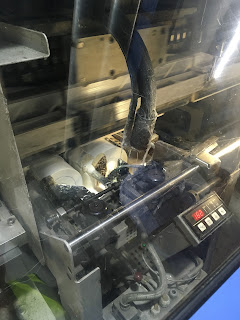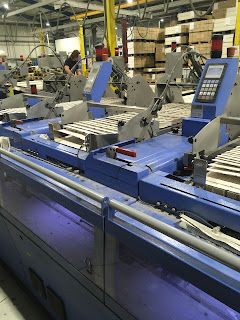 |
| Still warm, first edition Ready or Not |
So far in life, I've been round the Cadbury's chocolate factory in Hobart, Tasmania and the Jelly Belly factory in Fairfield, California. Yes, there were many edible freebies - which led to child two throwing up in the car park after too many jelly beans - but neither compared to the excitement for a book geek like me in seeing a book printed. Better still, one of my books.
My lovely publisher, Little Tiger Ltd, had it all planned to go for The Rules in 2020 but then a pandemic came along. This time round, the CPI Books factory in Chatham, Kent had just started readmitting visitors to the site. Phew, for once the publishing gods were in our favour.
Your books or many of the ones on your bookshelf, paperback and hardback, may well be printed at CPI too. Digital printing for low volume or on demand is at their Wiltshire sites but high-quality lithographic printing takes place at Chatham. (Picture books are generally printed in China due to higher costs.) CPI print around 450 million books per year across their printing factories.
In my excitement, I may not have grasped all the proper technical names for what I'm about to describe so apologies if so. I was too busy watching the conveyor belts go round and round or marvelling at the waterfall of printed paper above my head.
First off, we're going to need some paper. Soooo much paper.
Their warehouse is constantly emptying and filling with it. Different grains, colours, qualities all selected by the publisher for the particular book. You'll have seen that paper is in high demand and getting more expensive, exacerbated by the high cost of energy and the absence of paper from Russian mills. Swedish and Finnish forests are keeping us in books.
Here's me marvelling at the pristine paper on this 3 mile roll. I'll just say that again - 3 miles!
This is about to be attached to the printing press containing the huge aluminium plates used in lithographic printing with, in my case, 32 pages (I think!) on each sheet waiting to be inked.
These aren't all consecutive pages because they allow for folding and production of two books at a time. This is where maths and the ability to visualise a deconstructed book really matter for the production team. Thank goodness, this part is above my pay grade because I can't remember whether my book needs to have a number of pages divisible by 32 or 16. Either way, we've ended up with 288 pages. Hence the occasional blanks at the ends of books or in the case of Ready or Not, extracts of my other books. If I were writing illustrated early readers or middle grades rather than edgy YAs, the team would be working out that an illustration on one page means that there should also be one on its diagonally corresponding page on the sheet. OK, brain is hurting. It was complicated and why publishers and printers have a lot of meetings.
Ink is piped in through big tubes and the paper moves so quickly it looks static or like a marvellous, if rather noisy, water feature.
This huge sheet is then folded and clamped into bundles like this:
These bundles are left to dry before the next stage - binding them together.
Glue pellets are piped into the well-ventilated machinery and at such a high temperature the glue works instantly binding the six bundles into a very long (ie double) coverless book.
 |
| Glue pellets |
 |
| Hot glue applied to pages |
Next stop - the covers. The cover sheets with two covers on each are printed in their factory in Croydon and shipped to Chatham on the day of printing. It's all a just-in-time logistical process.
 |
| Cover stack fresh from Croydon |
 |
| Covers loaded into machine |
Covers are loaded into the machine and glued and clamped into place on the printed book, now on its side edge. The covers are then folded into place by the machine. This gives a 2 up book block, resplendent in orange, trundling round the double decker conveyor belt. They slowed the process down to half speed so that we were able to see what was going on.
The keen-eyed among you will have noticed that this is still a topsy-turvy double book. So next stop is the cutting machine where it gets cut into two books.
The books are all tilted into the same direction and off on the next conveyor belt to get those edges trimmed. I liked the thwack of books landing on this conveyor belt and the sight of all those books disappearing off into the distance.
Quality control keeps a close eye and rejects any that aren't quite perfectly trimmed before the machine neatly stacks them into piles.
Piles join together as logs to be wrapped in recyclable plastic to protect from sunlight and to more easily transport, and arrive on a pallet.
The forklift driver then takes the full pallet of books immediately onto a lorry to be sent to the distribution warehouse. I'll see them again when I'm sent my author copies to unbox.
We also had a look at how the other half live with hardback printing. I can see why hardbacks are so expensive; so many more processes. If I ever get a collector's edition, I'll ask for the full works: a patterned cloth cover, lined with contrasting colour cloth carefully tucked and folded, printed silver foil spine from a handmade block, head and tail band in striped fabric and a silk ribbon bookmark. Finished with laser-sprayed edges in a funky pattern and a snazzy loose cover with cut-out shapes. Boom.
We were looked after so well by Kevin at CPI - no jelly beans but plenty of sandwiches and cakes - and a patient willingness to answer all our questions.
Souvenirs from the day - cover sheets, pages bundle, a 2 up book block and, best of all, literally the first edition of Ready or Not. All you PB and MG authors with puppets and outfits and cuddly toys are sorted for school visits but us YA authors need some props to wave around and I can now waft my 2 up book block.
Sadly, I didn't manage to sneak out my Author hi-vis jacket.
Tracy Darnton is the author of YA thrillers. Her next book, Ready or Not, is definitely out in May. She personally watched over all the copies at the printers.















3 comments:
Oh that looks so fascinating! Congratulations and good luck!
That's a very interesting tour, Tracy. Thanks.
Great that you and the designers arranged such a bright and high-viz book-jacket just so we could follow the book's path in, through and along all the dull grey machinery too. :-)
The orangee does look attractively noticeable, so hope The Rules does - or is doing -really well!
Oops! My squinty eyes strike again.
Tracy Darnton's title is READY OR NOT and it's out in MAY!
Post a Comment